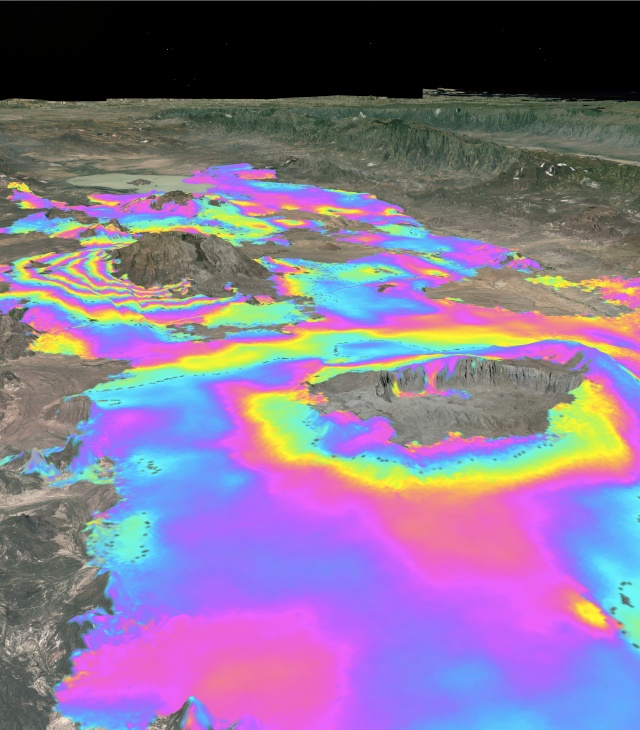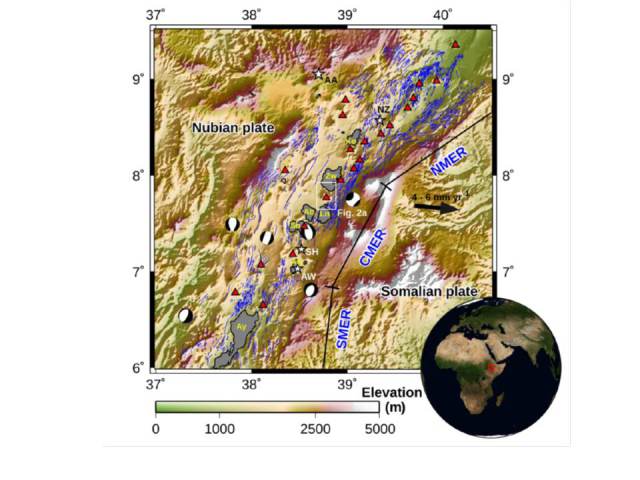Guest post by Ryan Lloyd, PhD student at the University of Bristol. (Originally posted here).
Last month I returned from the East African Rift: a 4000 km divide between two continents that are slowly moving apart. We were there to visit the Aluto, Corbetti and Bora volcanoes, in Ethiopia.
The volcanoes we visited are just three of the over 100 that populate the rift. They are especially important for a number of reasons. Firstly, they allow us to study the continental magmatic behaviour of a fundamental aspect of plate tectonics: divergent plate boundaries. These particular volcanoes are also interesting because of the diverse deformation patterns we have observed using satellites. When volcanoes are seen deforming, it is indicative of a change in volume or pressure beneath the volcano. In many cases, this is associated with an eruption, but, in the Main Ethiopian Rift, no recent eruptions have occurred.
We do not know what is causing the deformation at these volcanoes, and as such, further, field, investigations are necessary. The volcanoes are also sites of rapidly developing hydrothermal energy reserves, and are close to many important population centers.
Our primary aims, therefore, were to collect data that would allow us to determine how much deformation there has been at each of the volcanoes, and to try to elucidate what might be causing it. To do this we performed dynamic microgravity surveys, which allows us to comment on the mass change beneath the volcanoes since the last visit, and also to service several GPS stations. The GPS on the volcanoes are the same as that in your phone, except we leave them in one particular location for a long time to provide us with an incredibly precise measure of where they are, and how that fixed location may be moving with time.
I wanted to share with you some of the experiences I encountered, and observations I made along the way. The day before I left I confided in my research group that, in truth, I would probably, normally, consider myself a bit of a desk geophysicist. In an attempt to pacify my apprehension they kindly shared some advice, which I gladly pass onto you now:
1. No Slippers
2. No Snakes
3. Probably don’t eat the raw meat
4. Don’t drink the water (or the local home-brews).
Pretty sound advice; to be honest I had never been to sub-Saharan Africa before and had no idea what to expect.
I left for Addis Ababa, Ethiopia’s capital city, on the 23rd September 2015, and arrived safe and sound sometime in 2008… don’t worry, that’s not a typo. Ethiopia works on their own calendar, which is 7 years behind. They also work on “Ethiopian time” which is essentially the same as “European time” but their 1 o’clock is “our” 7am. Of course.
Arriving in Addis, I met Yelebe, our trip leader, and we went for breakfast. I’d been promised, before I left, that Ethiopia has a fantastic food culture, of which they were very proud. I have included some photos of some of my favourite breakfasts for you to at least feast your eyes on.
You’ll notice next to the raw meat the grey flannel. Yeah, that’s not a flannel, that’s injera. Injera is a sourdough made from semi-fermented grass seeds that is eaten with every single meal. If you go to Ethiopia you will see quite a lot of this stuff. I actually quite liked it. (One word of advice though, you do, however, have to relatively quickly get over the pretty-sure-this-sour-flannel-and-spicy-meat-does-not-go-with-my-toothpaste feeling…).
Addis is actually a fantastic introduction to Africa. It is high enough (2350 m) to be relatively cool, and free of Malaria. It is also a real travel and business hub in East Africa, construction seems to be constantly happening, and the city seemed safe enough such that if I wanted to, I’d have been happy to walk around it on my own (the same was also true for other places we stayed, such as Hawassa).
One of the reasons we were in Addis was to visit the Institute of Geophysics, Space Science and Astrophysics (IGSSA), who are part of the University of Addis Ababa. The IGSSA is where many of the Ethiopian collaborators in RiftVolc work, and having their local knowledge of Ethiopian customs and the volcanoes were imperative, I found, for a successful trip (they also have great coffee there).
I actually also felt exceptionally lucky to be in Ethiopia with the companions I had. The whole time I was with Yelebe, Birhanu (the other field assistant), and Eyaya (our driver), all of whom are Ethiopian. Being with them meant that I got a real feel for Ethiopian culture, and got to see how Ethiopians live their lives in a way that I don’t think you could ever really get as a tourist. I’d just like to take this moment to thank them for their patience in answering my continuous string of questions, and hearing my terrible attempts at speaking Ahmaric. Ah-ma-sa-ga-na-lu!
Being with them as well meant I got to find out what resident Ethiopians discuss over coffee; what bothers them day-to-day. At the moment, for example, many Ethiopians were concerned with the ongoing European migrant crisis. Plenty others had opinions on the new light rail service in Addis that only opened the weekend before I arrived. I also learnt about the local tribal politics, and, for example, their justice system. One thing I really appreciated learning about though, was the actual, physical, on-the-ground considerations required for fieldwork that a desk geophysicist would never even be able to imagine. I learnt about Ethiopia’s history, their religions, traditions, a little Amharic (and thoroughly recommend you do when you visit), and all the things they are proud of. I even know why the man from Jimma would bring coffee to Addis if there were a shortage.
Personally non-geophysical highlights include getting truly defeated at football by small children on the top of Aluto (never was my sport, anyway…). Seeing hippos was good (well, when we actually saw hippos and not just a flock of birds, Eyaya…), as was visiting a Rastafarian Church. I don’t know whether you know anything about Rastafarianism, but I think it’s worth looking up. Actually, strangely enough, the guy who showed us around the church was from Handsworth, an area of Birmingham, just 10 miles from where I grew up. Stranger still, Haile Selassie, Emperor of Ethiopia between 1930 and 1974, and the messiah in Rastafarianism, lived just 10 miles from where I’m sitting right now, in the late 1930’s, in Bath. Small world, eh?
It was also fantastic to be involved in the celebration of Meskel, an Orthodox Christian holiday to celebrate the rediscovery of the cross on which Jesus was crucified. The celebrations generally seemed to involve several really quite large bonfires, coffee and butchering a goat.
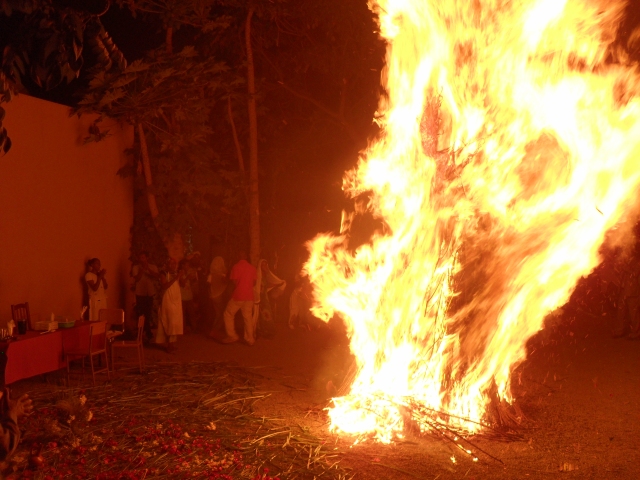
Meskel celebrations at Hotel Bethlehem, Ziway
Anyway, despite what this blog so far probably suggests, we did actually do some geophysics. Personally, I was pleased with what we were able to do in the field. It was great to see how GPS stations are deployed; I hadn’t realised how difficult it could be to find a good site for them, for example. A good site requires solid rock for the equipment to be installed on, and also a trusted guard, who lives nearby, and is happy to keep an eye on it. It was also great to go and see with my own eyes what something that has always been a vector on a map of the volcanoes actually looks like in real life.
Left: The gravimeter on Aluto volcano. The gravimeter is the piece of kit that allows us to measure the gravity at a particular location, relative to a base station. Right: Installation of a GPS station near to the rift border faults. It was great to see how much the local villagers (one we befriended was a physics teacher) wanted to be involved, or know more about, the project.
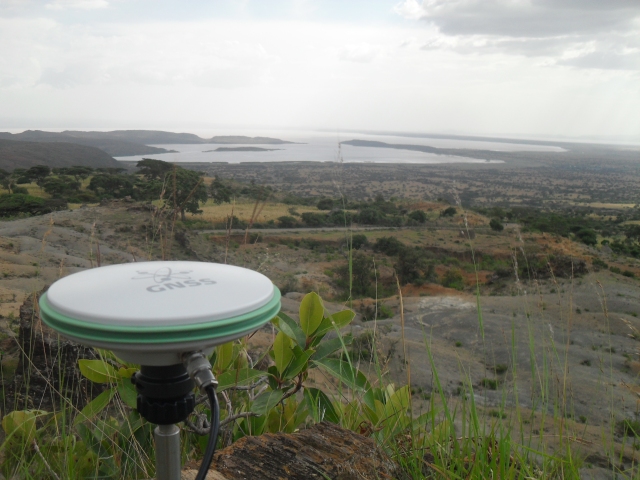
View south from a GPS station on Aluto, across Lake Langano.
The Ethiopia I saw is nothing like the famine stricken picture portrayed by Bob Geldof in the 1980s, which is unfortunately the image that I think many people have of the country. I really encourage you to go, and find out for yourself, as I hope to again.
For now though, I leave an incredibly formative and informative to trip a little less of a desk geophysicist, and a lot more a fan of Ethiopia.
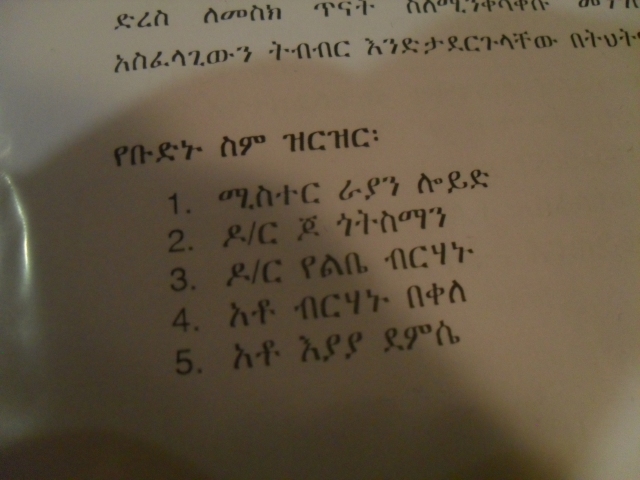
Our crew. No 1 is ‘Mr Ryan Lloyd’ in Amharic
